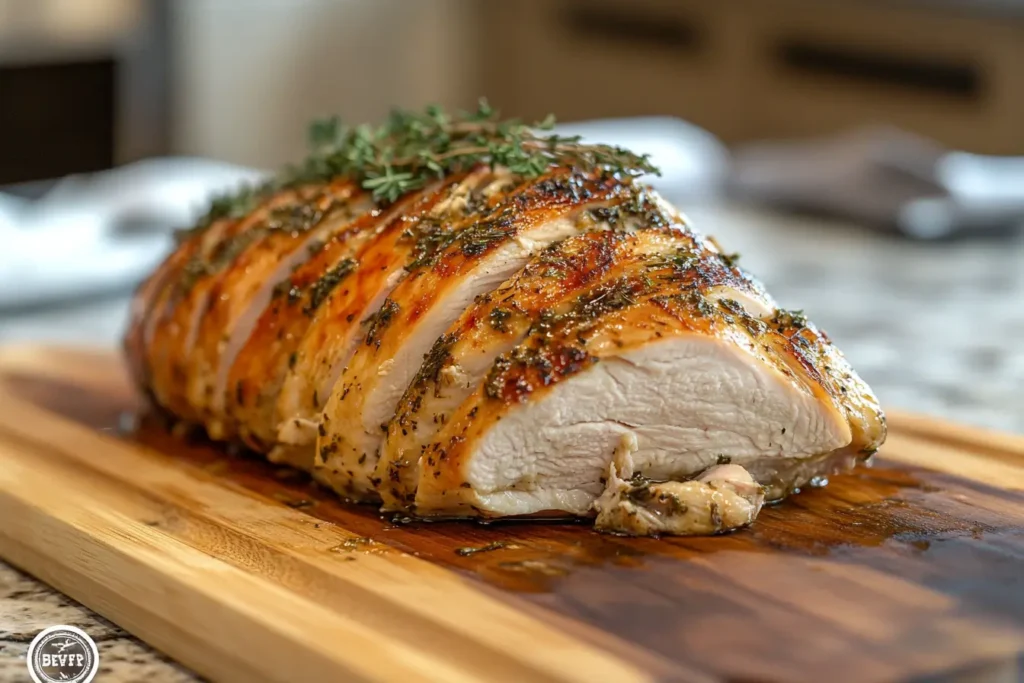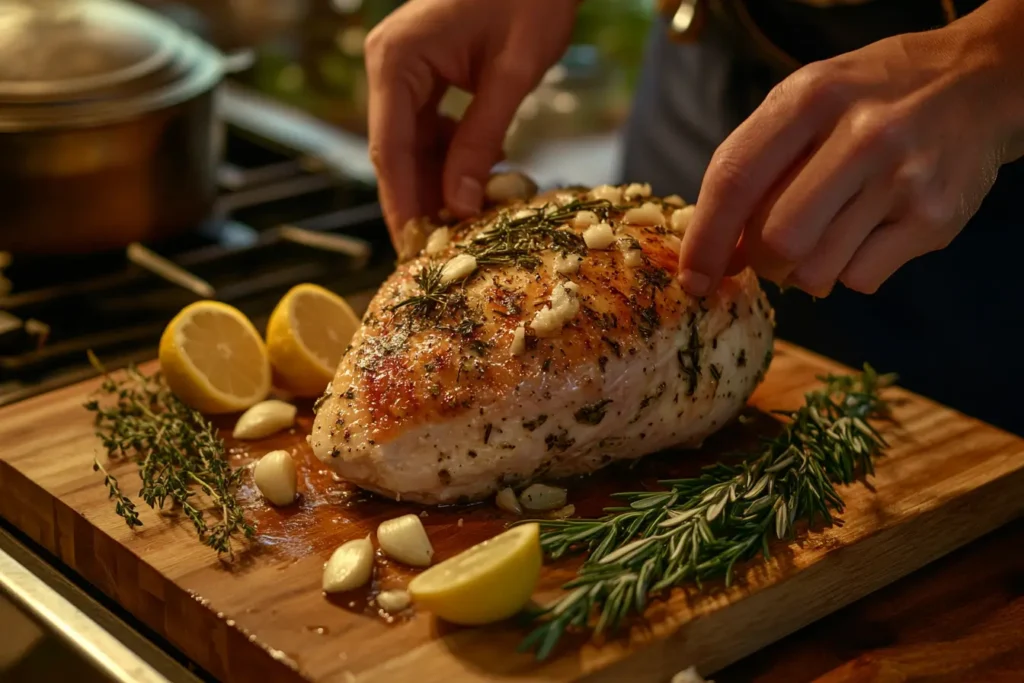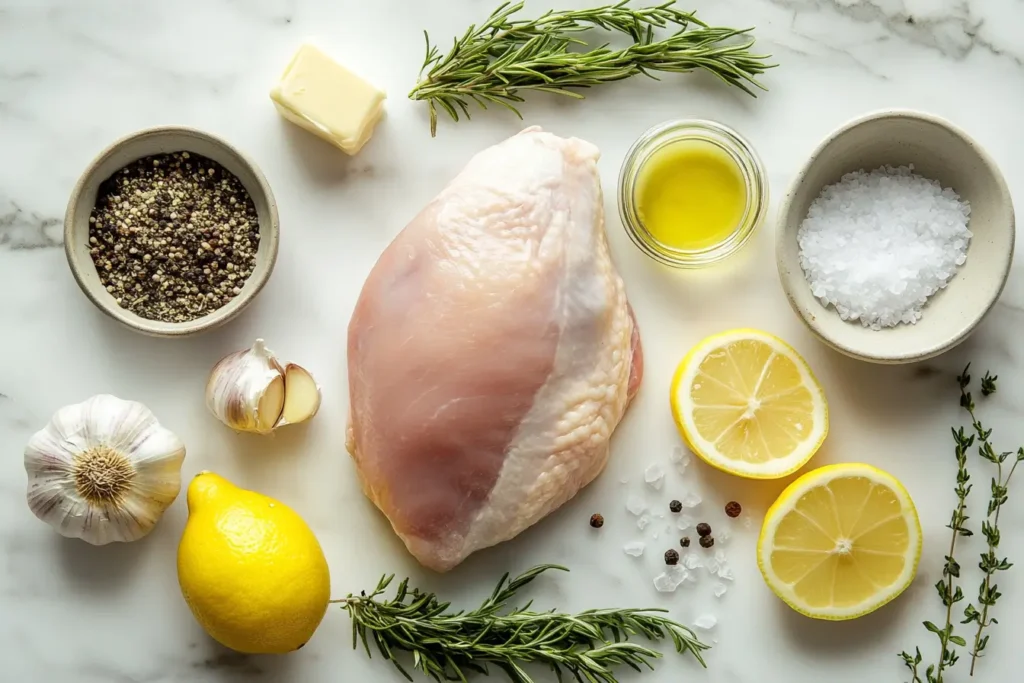Let’s be honest—cooking a whole turkey can feel like tackling a Thanksgiving marathon. But what if you could enjoy all the juicy, flavorful goodness of turkey without the stress? Enter Butterball turkey breast, the unsung hero of easy and delicious meals.
Whether you’re planning a holiday feast, a cozy Sunday dinner, or meal prepping for the week, this turkey breast is a game-changer. It’s convenient, packed with flavor, and perfect for any occasion. Plus, there are countless ways to prepare it—roasted, slow-cooked, grilled, or even air-fried!
In this guide, we’ll cover everything you need to know about Butterball turkey breast—from selecting the right type to cooking it to perfection. By the end, you’ll have all the tips, tricks, and recipes you need to become a turkey expert in your kitchen.

Table of Contents
What is Butterball Turkey Breast?
A Brief History of Butterball
Butterball has been a household name for decades, known for its high-quality poultry products. Founded in the 1950s, the brand quickly became synonymous with tender, juicy turkeys. What sets Butterball apart? Their turkeys are pre-brined, meaning they come infused with just the right amount of salt and seasoning to ensure a flavorful and moist bite every time.
Types of Butterball Turkey Breast Available
Before you head to the grocery store, it’s good to know that Butterball offers different types of turkey breasts. Here are the main options:
- Boneless Turkey Breast – Great for quick and easy meals. It’s compact, cooks faster, and is easy to slice.
- Bone-In Turkey Breast – This delivers extra juiciness and a richer flavor, thanks to the bone. It’s the perfect option for a classic roasted turkey experience.
- Frozen vs. Fresh – If you like to plan ahead, frozen is a great choice. If you’re cooking soon, go for fresh to save time on thawing.
Why Choose Butterball Over Other Brands?
With so many turkey brands out there, why pick Butterball?
✔️ Pre-brined for extra juiciness – No need to worry about dry turkey!
✔️ High-quality meat – Always tender and flavorful.
✔️ Easy-to-follow cooking instructions – Perfect for beginners.
✔️ Widely available – You’ll find Butterball turkey breasts in most grocery stores.
If you’re looking for a reliable, foolproof turkey breast, Butterball is a top-tier choice.
How to Prepare Butterball Turkey Breast
Thawing Instructions for Best Results
If you bought a frozen Butterball turkey breast, proper thawing is crucial for even cooking. Here’s how to do it safely:
- Refrigerator Method (Best Option) – Place the turkey breast in a shallow pan in the fridge. Allow 24 hours of thawing time per 4 pounds of turkey.
- Cold Water Method (Faster) – Submerge the turkey breast in cold water, changing the water every 30 minutes. This takes about 2 hours for a 3-4 pound breast.
❗ Never thaw turkey at room temperature—this invites bacteria and can lead to food safety issues.
Seasoning and Marinating Tips
Since Butterball turkey breasts are pre-brined, you don’t need to add extra salt. But if you want to boost the flavor, try these ideas:
- Herb Butter Rub – Mix softened butter with minced garlic, rosemary, thyme, and black pepper. Spread it under and over the skin.
- Citrus & Herb Marinade – Combine lemon juice, olive oil, garlic, and fresh herbs for a fresh, zesty taste.
- Smoky BBQ Glaze – Brush the turkey with a mix of honey, smoked paprika, and Worcestershire sauce for a sweet and smoky flavor.
Common Mistakes to Avoid When Prepping
🚫 Skipping the thawing process – A partially frozen turkey won’t cook evenly.
🚫 Not patting the turkey dry – Excess moisture can prevent crisp skin.
🚫 Forgetting to let it rest – After cooking, let the turkey rest for at least 10 minutes to retain its juices.

Cooking Methods for Butterball Turkey Breast
Oven Roasting: The Classic Method
If you love that golden, crispy skin, roasting is the way to go.
How to Roast a Butterball Turkey Breast
- Preheat your oven to 350°F (175°C).
- Prepare the turkey – Place it on a rack in a roasting pan, skin-side up. Pat it dry and brush with melted butter or oil.
- Season with herbs and spices.
- Roast for about 20 minutes per pound, or until the internal temperature reaches 165°F (75°C).
- Let it rest for 10-15 minutes before slicing.
Slow Cooker: Set It and Forget It
Want a hands-off approach? The slow cooker keeps the turkey incredibly juicy.
How to Slow Cook a Butterball Turkey Breast
- Place the turkey in the slow cooker, breast-side up.
- Add aromatics like onions, garlic, and fresh herbs.
- Pour in ½ cup of broth to keep it moist.
- Cook on LOW for 6-8 hours or HIGH for 3-4 hours.
- Check the internal temp to ensure it reaches 165°F.
Air Fryer: Crispy Perfection
Yes, you can cook a turkey breast in an air fryer! This method delivers crispy skin with minimal oil.
How to Air Fry Butterball Turkey Breast
- Preheat the air fryer to 350°F.
- Rub the turkey with oil and seasonings.
- Place in the air fryer basket, skin-side up.
- Cook for 30-40 minutes, flipping halfway through.
- Rest and slice before serving.
Grilling for a Smoky Flavor
Grilling a turkey breast adds a smoky, charred flavor that’s hard to resist.
How to Grill Butterball Turkey Breast
- Preheat the grill to medium heat (around 375°F).
- Rub the turkey with oil and spices.
- Grill over indirect heat for 90 minutes, flipping once.
- Use a meat thermometer to ensure it’s fully cooked (165°F).
🔥 Pro Tip: Add wood chips for extra smokiness!
Perfect Side Dishes to Pair with Butterball Turkey Breast
A delicious turkey breast deserves equally amazing side dishes! Whether you’re serving it for a holiday feast or a simple weeknight dinner, these sides will take your meal to the next level.
Traditional Thanksgiving Sides
If you’re making Butterball turkey breast for Thanksgiving or another festive occasion, you can’t go wrong with these classics:
- Mashed Potatoes & Gravy – Creamy, buttery mashed potatoes with homemade turkey gravy? Yes, please!
- Cranberry Sauce – A tangy, slightly sweet contrast to the savory turkey.
- Stuffing (or Dressing) – Whether you bake it inside the turkey or as a side dish, stuffing is a must-have.
- Green Bean Casserole – A crunchy, creamy side that pairs beautifully with turkey.
- Dinner Rolls – Soft, fluffy rolls perfect for soaking up that gravy.
Low-Carb and Healthy Options
Looking for something lighter? Try these healthy sides:
- Roasted Brussels Sprouts – Toss with olive oil, garlic, and balsamic glaze.
- Cauliflower Mash – A low-carb alternative to mashed potatoes.
- Garlic Butter Asparagus – Quick, easy, and full of flavor.
- Quinoa Salad – Adds protein and texture to your plate.
Creative Leftover Ideas
Got leftovers? Reinvent them with these ideas:
- Turkey Cranberry Sandwich – Layer turkey, cranberry sauce, and stuffing on a toasted bun.
- Turkey Caesar Salad – Dice leftover turkey and toss it with crisp romaine and Caesar dressing.
- Turkey Tacos – Shred turkey and season with taco spices for an easy taco night.
- Turkey & Rice Soup – Simmer turkey, veggies, and rice in a comforting broth.
Common Problems and How to Fix Them
Even the best cooks run into kitchen mishaps. Here are the most common turkey breast problems and how to solve them!
Problem #1: The Turkey is Too Dry
Solution:
- Baste, baste, baste! Spoon melted butter or pan drippings over the turkey every 30 minutes.
- Cover with foil to trap moisture while roasting.
- Add broth before reheating leftovers to bring back juiciness.
Problem #2: The Skin Isn’t Crispy
Solution:
- Pat the turkey dry before seasoning.
- Rub with butter or oil for extra crispiness.
- Roast uncovered for the last 20 minutes.
Problem #3: The Turkey is Undercooked in the Middle
Solution:
- Use a meat thermometer and check that the thickest part reaches 165°F.
- Tent with foil and let it rest—carryover cooking will help.
- If needed, return to the oven at 350°F for an extra 10-15 minutes.
Problem #4: The Turkey is Overcooked and Tough
Solution:
- Slice thinly and add gravy to add moisture.
- Shred it and use in soups or sandwiches where extra sauce can help.
🔗 Want to make the perfect gravy? Check out this Chicken Broth Meal Guide.
Butterball Turkey Breast Recipe: Herb Roasted Perfection
Now, let’s get to the best part—a foolproof herb-roasted Butterball turkey breast recipe that will impress everyone at the table!
Ingredients
- 1 Butterball boneless turkey breast (about 3 lbs)
- 3 tbsp unsalted butter, melted
- 2 tbsp olive oil
- 1 tbsp garlic powder
- 1 tbsp onion powder
- 1 tsp paprika
- 1 tsp dried thyme
- 1 tsp dried rosemary
- 1 tsp black pepper
- ½ tsp salt
- 1 cup chicken broth
- 1 lemon, sliced
- 3 cloves garlic, crushed
Instructions
- Preheat oven to 350°F (175°C).
- Pat the turkey breast dry with paper towels. This helps crisp the skin.
- In a bowl, mix melted butter, olive oil, and seasonings.
- Rub the mixture all over the turkey breast, getting under the skin if possible.
- Place turkey in a roasting pan with the lemon slices and crushed garlic around it.
- Pour the chicken broth into the bottom of the pan to keep the turkey moist.
- Roast for about 1.5 to 2 hours, or until the internal temperature reaches 165°F. Baste every 30 minutes.
- Remove from the oven and let it rest for 10 minutes before slicing.

Nutrition Facts
| Nutrient | Per Serving (6 oz) |
|---|---|
| Calories | 260 |
| Protein | 40g |
| Carbohydrates | 2g |
| Fat | 10g |
| Saturated Fat | 3g |
| Sodium | 580mg |
| Fiber | 0g |
Servings: 4-6
Prep Time: 10 minutes
Cooking Time: 1.5 to 2 hours
Total Time: ~2 hours
Recipe Notes
- For extra crispy skin, broil for the last 5 minutes.
- Leftovers? Store in an airtight container in the fridge for up to 4 days.
- This turkey breast is great for meal prep—slice it up for sandwiches, salads, or wraps.
FAQs About Butterball Turkey Breast
Let’s clear up some common questions about cooking and serving Butterball turkey breast.
Q1: How long does it take to cook a Butterball turkey breast?
✅ The cooking time depends on the method and weight:
- Oven roasting: About 20 minutes per pound at 350°F.
- Slow cooker: 6-8 hours on LOW or 3-4 hours on HIGH for a 3-4 lb breast.
- Air fryer: 30-40 minutes at 350°F.
- Grill: About 90 minutes over indirect heat at 375°F.
Q2: Should I brine a Butterball turkey breast before cooking?
❌ Nope! Butterball turkey breasts are pre-brined, so they already have the right amount of salt and moisture. However, you can add extra flavor with a spice rub, marinade, or herb butter.
Q3: Can I cook a Butterball turkey breast from frozen?
✅ Yes, but it takes longer. If you didn’t have time to thaw, follow these steps:
- Preheat your oven to 325°F.
- Place the frozen turkey breast on a rack in a roasting pan.
- Cover loosely with foil and roast for about 50% longer than a thawed turkey (estimate 30 minutes per pound).
- Use a meat thermometer to ensure the internal temp reaches 165°F.
🔗 Need a side dish? Try this Best Cranberry Bread Recipe Ever for a perfect pairing.
Q4: Is Butterball turkey breast gluten-free?
✅ Most Butterball turkey breasts are gluten-free, but always check the label for any added ingredients. If you have dietary restrictions, look for the “gluten-free” label on the package.
Conclusion: Why Butterball Turkey Breast is a Must-Try for Every Home Cook
Cooking a Butterball turkey breast is one of the easiest ways to enjoy a delicious, home-cooked meal without the hassle of preparing a whole turkey.
✅ Convenient & Easy – Perfect for small gatherings or weekly meal prep.
✅ Juicy & Flavorful – Pre-brined for consistent results every time.
✅ Versatile Cooking Options – Roast it, slow cook it, air fry it, or grill it.
✅ Pairs Well with Everything – Classic sides, healthy options, or leftovers!
Whether it’s a special occasion or just a weeknight dinner, Butterball turkey breast is a no-fail meal that never disappoints. Try it with your favorite sides, experiment with different cooking methods, and enjoy a meal that’s both comforting and delicious.
Now it’s your turn! Have you tried cooking Butterball turkey breast? What’s your favorite way to prepare it? Let’s talk in the comments! 👇😊
